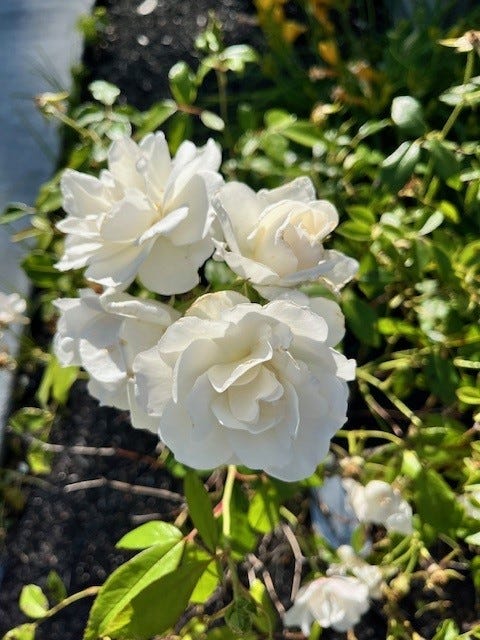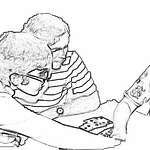June 16 - June 25, 1942.
Summary:
Alexander Schmorell, Christoph Probst, Hans Scholl, and Sophie Scholl decide that Hans and Alex would each generate a leaflet draft. They would then meld the documents into a single manuscript. The ultimate in collaborative writing!
Alex borrows an American-made Remington typewriter from his neighbor, Karl Pötzl, telling him he had started writing poetry. Alex also buys an inexpensive, hand-cranked Greif duplicating machine. They run off 100 copies of the first leaflet - four pages long! Alex pays for all supplies out of his allowance. They borrow his father’s telephone directory and work in his room.
The friends choose the White Rose symbol as their image or “brand” (in 21st century terms). Lilo’s friend Fritz Rook had written her a letter about white roses in which he said that death, love, and youth are all the same. Drawing on old Germanic notions of white roses and death, Fritz Rook spoke of the white rose’s fragrance and “fragile purity.” The friends call this: Leaflets of the White Rose. I.
The Leaflets of the White Rose therefore point the reader to the well-known literary symbol, not to the people writing the words. This is critical to remember as the story progresses.
This first leaflet draws heavily on German literature, especially words penned by Goethe and Schiller. Although long, the document is clear. These students do not let fellow citizens off with indifference or inaction. They emphasize that Germans are getting the government they deserve, that unless they take action, they will be subject to shame when “the awful crimes that infinitely exceed any human measure are exposed to the light of day.”
Unsure of themselves, they send up two test balloons before the mass mailing goes out. First they mail one to Professor Huber. And second, Hans Scholl gives a copy to Traute Lafrenz.
2007 update, Fritz Hartnagel has moved from in-town quarters in Mariupol to a tent in the Donbas. Despite decreeing that he and his men do not have to wear uniforms (they wear “track clothes” instead), he is miserable. Rampant alcoholism makes his job as C.O. unpleasant.
Why This Matters:
It is beyond difficult to keep going when we see no results from our efforts. Alex’s statement about the reception to this first leaflet, even among their trusted friends, underscores the discouraging nature of “good trouble,” of doing what is right.
I relish the discomfort caused to Professor Richard Harder as he tries to define how ‘the author’ knew about failed resistance movements, without disclosing that he - Professor Harder - also listened to foreign broadcasts. A sweet reminder that more Germans knew what was really happening, than would own up to that knowledge after the war. ——- And this was the primary point of the leaflets!
When you have undertaken a tough task, what have been the roadblocks you’ve encountered? How did you get past them? Please post in the comments!
White Rose History, Volume II, pages 60-66. Yes, this was longer than usual, because there wasn’t a natural “break” in the narrative.
Notes and references available only to paid subscribers.
Notes and references
For the Remington typewriter, the serial number of NL82533 corresponds to the 2,533rd Remington Portable Typewriter #2, manufactured in March (the L) 1928 (the 8). If it had been manufactured for sale in Britain, it would have been called a Smith Premier; in France, a Contin. There is no explanation in any Gestapo transcripts as to how the Pötzl family came to own an American typewriter. - Dr. Richard Polt is the expert on all things typewriter.
Believe it or not, this crazy typewriter has a saga all its own. Freisler immediately claimed it once the trial was done and seemed to have been quite angry when it was not promptly delivered to him. Karl Pötzl then retained an attorney to have it returned to him. The Gestapo, People’s Court, and Pötzl family wrangled over this typewriter for years. Earned attorneys some nice legal fees.
In one of Hans Scholl’s early interrogations, he claimed to have done everything himself. Later, he more clearly delineated the roles and division of responsibility between himself and Alexander Schmorell, most of which is not contradicted by Alex’s later statements. The only point of disagreement remains: Who purchased the duplicating machine? Hans claimed he did, while Alex claimed he did. In one indictment, it states Hans did, and in the second, it states that Alex did. Because of one of Hans’ statements regarding the duplicating machine (“We took the apparatus to Schmorell’s house; I could not say whether we carried it there together”), it is probable that they made this purchase together.
Hans Scholl also acknowledged that he knew what they were doing would be deemed ‘propaganda.’ “I acted on the assumption that concrete concepts must be present in effective propaganda – the concepts would mean nothing in and of themselves, but would sound good and would give the impression that there was an agenda to the propaganda.”
Regarding the Fritz Rook letter: At my request, Lieselotte Fürst-Ramdohr provided a photocopy of the original letter from 1941, along with a photocopy of the elegant Max Baur White Rose postcard that had followed his letter.
The other contradictory origins for the White Rose name were likely given to the Gestapo to protect Lilo Berndl. These false reasons included: Randomly selected, attributable to a Spanish novel by that name; randomly selected, based on Brentano’s Spanish ballad “Die Rosa Blanca”; not connected to the White Rose of English history, or the girls’ organization by that name; and, the white rose the exiled French aristocracy used as a symbol on their flags.
Regarding the irregular paper size, not insignificant as it gave the Gestapo an unusual clue to pursue: “Quarto” could have been 22 x 27 cm (small quarto), or 24 x 30 (medium quarto), or 26 x 33 (large quarto), all papers used to manufacture books, whereas normal letter-sized stationery would be 210 x 297 mm (1/4 of a square meter).
Regarding the pre-Sophie comment of the leaflet draft: Hans Scholl said he wrote the draft of the first leaflet while he was living at Athener Platz 4, before Sophie came to Munich.
Finally, regarding my rather unorthodox dating of the generation of the first leaflet (nothing in 2002 was even close to what I wrote): This rather unorthodox conclusion was not drawn out of thin air, but resulted from working the database.
There are three constants to the last week of June 1942.
Willi Graf was at the soiree held at Alex Schmorell’s house;
Professor Huber and Traute Lafrenz had read the leaflet before the soiree (Huber’s had been mailed to him, Hans had showed the leaflet to Traute); and,
The main leaflet mailing took place on June 27.
The only way that Willi Graf could have been at the soiree was for it to have taken place on June 25, 1942.
Earlier dates don’t work because it moves up the timeline for Leaflet I too much.
6/26 is out, because Willi Graf went to a movie that night;
6/27, Willi spent the evening in the Siegfried Strasse;
6/28, Willi went to a concert;
6/29, Willi was at Bach Chorale; and,
6/30, Willi also went to the movies at night.
On June 25, Willi also went to the Siegfried Strasse, but one infers from his diary entry that he went in the afternoon. When working on this database, Willi Graf’s succinct diary entries “pegged” many of their activities, because until February 1943, he seems to have kept it in real time. So dates are more accurate.
For Traute and Professor Huber to have read the leaflet before Alex’s soiree, they had to have generated it earlier and waited to gauge initial reactions before committing to a widespread effort.
Flores, Angel (Ed.). An Anthology of Poetry from Hölderlin to Rilke in English Translation. Gloucester, MA: Peter Smith, 1965.
Fürst-Ramdohr, Lilo. Freundschaften in der Weiβen Rose. Munich: Verlag Geschichtswerkstatt Neuhausen, 1995.
May 29, 1999 letter from Hubert Furtwängler to George J. Wittenstein, forwarded to me on June 9, 1999 by GJW.
Hartnagel, Thomas (Ed.). Sophie Scholl, Fritz Hartnagel: “Damit wir uns nicht verlieren”: Briefwechsel 1937-1943. Frankfurt am Main: S. Fischer Verlag, 2005.
Holzenburg, Gerhard. Vom Entwurf bis zur fertigen Drucksache. Göttingen: Musterschmidt, 1974.
Knoop-Graf, Anneliese and Jens, Inge (Eds.). Willi Graf: Briefe und Aufzeichnungen. Frankfurt am Main: Fischer Taschenbuch Verlag GmbH, 1994.
Lafrenz, Traute. “Bericht.” Letter to Inge Scholl, dated February 21, 1946. Unpublished.
Polt, Richard. The Classic Typewriter Page Presents Remington Portables. Retrieved from http://staff.xu. edu/~polt/typewriters/rem-portables.htm.
NJ1704, Volume 1, part 1. 4/8/1943 indictment.
RGWA I361K-1-8808. Alexander Schmorell: Gestapo Interrogation Transcripts. 2/25/1943 interrogation of Alexander Schmorell; 3/10/1943 interrogation of Karl Pötzl.
Third White Rose Trial. 3/16/1943 interrogation of Josef Söhngen.
ZC13267, Volume 1, part 1. 2/18/1943 analysis of the first four White Rose leaflets by Professor Richard Harder.
ZC13267, Volume 1, part 2. 2/21/1943 indictment of Hans and Sophie Scholl and Christoph Probst; 2/22/1943 verdict with reasons; 7/1/1943 letter from Dr. Deisinger to prosecutor’s office in Berlin.
ZC13267, Volume 2. 2/21/1943 interrogation of Hans Scholl; 2/20/1943 interrogation of Hans Scholl.
ZC13267, Volume 3. 2/19/1943 interrogation of Sophie Scholl; 2/20/1943 interrogation of Sophie Scholl.
ZC13267, Volume 6. 3/19/1943 interrogation of Traute Lafrenz. Publication in 2024/2025.
ZC14116, Volume 1. 2/22/43 interrogations of Hans and Susanne Hirzel (single document, separate interrogations). Publication in 2024/2025.
Podcast © 2024 Denise Elaine Heap. White Rose History, Volume II, Chapter 05 © 2002, 2007 update © 2007, Denise Elaine Heap and Exclamation! Publishers. Please contact us for permission to quote.
This podcast is a project of WHY THIS MATTERS, a newsletter of Center for White Rose Studies, that explores the reasons that voices silenced more than eighty years ago still speak to us today.
To order digital version of White Rose History, Volume II, click here. Digital version of White Rose History, Volume I is available here.












